Email: viktvlad@mail.ru
Revised 27 January 2022
Accepted 25 November 2022
Available Online 10 January 2023
- DOI
- https://doi.org/10.55060/s.atssh.221230.003
- Keywords
- Medieval architecture of Abkhazia
Reliefs of the temple
Iconographic sculpture - Abstract
This article is devoted to the stylistic and iconographic analysis of the relief decor of the White Temple in the village of Taglan (Abkhazia) in the context of Abkhazian medieval sculpture, revealing the analogues of the examined reliefs in the sculpture of Georgia, Armenia, Alania, Ingushetia, the Byzantine Empire and their dating. The academic novelty is due to the fact that this is the first attempt at detailed research of the sculptural decoration of the White Temple in the village of Taglan. A comparison with the revealed analogues lets us approximately date the reliefs back to the 11th–12th century.
- Copyright
- © 2022 The Authors. Published by Athena International Publishing B.V.
- Open Access
- This is an open access article distributed under the CC BY-NC 4.0 license (https://creativecommons.org/licenses/by-nc/4.0/).
1. INTRODUCTION
Architectural plastic arts of medieval Abkhazia have become a subject of a number of deep scientific studies [1,2,3,4,5,6,7,8]. But some of its monuments still have questionable dating and provoke discussion, concerning the rendition of some images. It can be explained, firstly, by the inconsistency of the extant works; it complicates the creation of a complete picture of the evolution of sculpture; secondly, by the ability of its repetitive use in the Middle Ages; thirdly, by the complexity of the cultural phenomenon itself. Truly, in Abkhazian architectural plastic arts one can find not only the reflection of Caucasian traditions connected, particularly, with the legacy of the Koban or Urartu cultures, but also the influence of early Christian art, the Byzantine Empire, presented by different cultural centers, synchronous in time works of sculpture in the temple architecture of Georgia and Armenia, finally, traditions going back to the art of Assyria, Iran, the Scythians and the Sarmatians. It is especially true about settled symbols and composition of zoomorphic character which got a new rendition during the Christian period. The goal of the research is to put forward a version, concerning the dating of the reliefs in the temple in the village of Taglan back to the 11th–12th century. Objectives: the study of iconography, composition, stylistics of zoomorphic and anthropomorphic reliefs of the temple; revealing their analogues; validation of the dating of the reliefs back to the 11th–12th century.
The sculptural décor of the White Temple (Cheokhvame) in the village of Taglan, due to the estimated late dating of the monument itself, was not represented in published works devoted to the plastic art of the Kingdom of Abkhazia.
2. MATERIALS AND RESEARCH
The temple has one nave and is made of cobblestone with a nearly lost lining of flagstone. Y.N. Voronov wrote: “Its stone vault rests on arches which lean on rectangular slabs-consoles protruding from the wall. On a significant height in the walls of the altar there are big, ornamented resonator jugs… On the western facade the edge of the roofing is decorated with the slabs with the images of birds, animals, different ornaments. The altar window, on the outside, is covered with a stone with a cross carved on it.” [9]
Apart from this cross, reliefs in situ can be found on the slabs situated along the upper edge of western and southern facades. These slabs have molding, along whose lower edge one can see a fascia and a fusarole. The concave surface – the background of sculptural images – is covered with herringbone stabbing, which resembles a woven mat [10]. On the northern slope of the gable of the western facade there is a slab with a poorly preserved zoomorphic image, maybe, a scene of laceration by a bird of prey (?), and on the southern – four slabs two of which are covered with an ornament, including sinuous lines and cup depressions [11]. On the third slab the image is nearly lost, maybe it was a bird. The relief on the fourth slab is relatively well-preserved; it shows profile figures of two birds facing each other (Fig. 1). Slabs with ornamental and figurative décor interchange. Along the upper edge of the southern facade preserved several slabs with molding, the one near the western facade is decorated with sculptural décor. It shows an image of a feline predator in profile to the right complemented by a sinuous ornament in front of and under the figure.
Besides, in front of the temple there are three more fragments of molding: with stabbing, a sinuous ornament and with a rotating solar sign in a circle. Here, in front of the temple, is a slab on whose narrow side is carved a cross likened to an eight-beam rosace in a ring of cable-stich, on the long side a schematic figure of an adorant, and the background is also covered with stabbing. Near one can see a shattered fragment of a slab with an equivalent rosace.
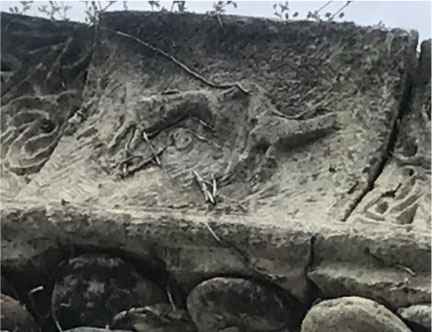
Relief on the White Temple. Photo by V.V. Pishchulina.
The location of reliefs on the concave side has many analogues in the sculptural décor of the temples of Transcaucasia, starting with an animalistic carving of the column cap of Bolnisi Sioni (5th century), vegetative ornaments are situated directly on the molding in the decoration of the Tsughrughasheni temple, the antechurch of the Damnisi temple (13th century). The location of the animal figures along the upper edge of the facade has a parallel in the Temple on Akdamar Island (10th century), which is famous for in sculptural decoration.
3. DISCUSSION
We proceed to the analysis of the sculptural images on facades which demonstrate stylistic unity. In iconography the theme with birds – portrayed in profile facing each other in a heraldic composition on the sides of a cross, a grapevine or a chalice – is one of the most popular motifs of early Christian visual and applied and decorative art. An object between two figures in the relief of Taglan cannot be clearly read, possibly, it is a chalice. The figures are carved without a strict symmetry, the head and the neck of the left bird are leaned towards the chalice, of the right bird, on the contrary, are elevated. The nearest compositional analogue to the relief of Cheokhvame – a widely famous slab with birds from the temple in the village of Mramba – which has a questionable dating (Fig. 2). For example, E.Y. Endoltseva writes: “In what concerns this slab with birds, L.G. Khrushkova first suggested dating it back to 6th–7th century or to a later period (7th–8th century), but then she dated it back to the 6th century”, and suggests dating the slab back to “the first half of the 11th century” [2]. But in this case the analogy can be seen only in composition. Stylistically the birds of Taglan are made in a different way; they are interpreted not in the planar-graphical manner, but in volume, in a higher relief, with revealing the plastics of the figures.
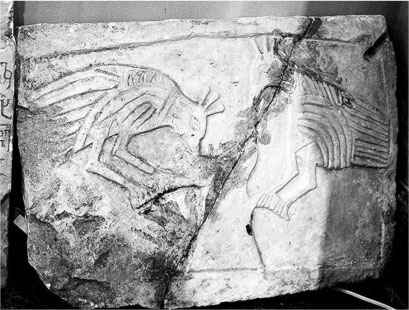
Relief on temple in the village of Mramba [10].
The figure of a feline predator from the southern facade (Fig. 3) is made in comparable stylistics. The integrity of the relief lets us only suppose which animal could be its vis-à-vis – most probably, it was a similar predator. In this case, its nearest iconographic and stylistic analogue is the slab in Lashkender Temple (Fig. 4). M.M. Trapsh [12], Sh.D. Inal-Ipa [13] and L.G. Khrushkova [8] see dogs in these animals; Y.N. Voronov [9], A.Y. Skakov and A.B. Jopua see leopards; in a later work A.Y. Skakov concludes that the images are syncretic [5]. In our opinion, the animals in the images are felines.
Unfortunately, the Lashkender temple still has not been dated precisely, the dates can vary between the 7th and the 11th centuries. On the relief of Taglan the predator is shown in profile to the right, with his front left paw raised. The figure has an expressive silhouette which is quite realistic but at the same time with a hint of decorativeness. The outline of the neck smoothly turns into the curve of the back and the elastic line of the tail, sharp ears are indicated in detail, the entire volume of the figure is softly modeled. The absence of the right part of the composition complicates the deciphering of the semantics of the image; it is not clear whether it is connected with Christianity or has the heraldic function like the relief of the Proshians’ mausoleum (Fig. 5) in Geghard (13th century), where the lions are represented in an emphatically geometrized manner. As A.L. Jakobson wrote, “The images of the predators – panthers, leopards, lions, … rare in the Byzantine Empire, are widely represented in the monumental plastic art of Transcaucasia, the Near East, the Middle East – in Persia, Mesopotamia, Asia Minor – both in Christian and Muslim countries in the 10th century and later (11th–13th century). These images of mighty animals, which became feudal symbols of strength and bravery in 9th–10th century, were popular in the countries close to the central Byzantine regions: in Macedonia, Bulgaria, Greece, where their emersion is due to the eastern sources. The place for slabs with such images, - the wall of a palace or a rich house, the battle side of a fortification wall or tower, the facade of a temple or even a choir screen – demonstrates the meaning of these images, which were the protectors, guards of a temple, house or city (for examples, a leopard, according to N.Y. Marr, the coat of arms of the capital of Armenia – Ani).” [14]
The “feline” relief in Taglan is stylistically close to many animal figures (Fig. 6) in the temple in Akdamar Island (10th century), the lion from the gates of Ani (Fig. 7), the lion and the bull carved on the slab from the museum in Erzincan (Fig. 8). The last slab and the Taglan reliefs have a similar ornamental motif which, in case of Taglan, is of a sophisticated, ornate character. This motif can be compared, first, to the undulating lines of the background of the reliefs in the Kyafar tomb (11th century), second - with images of marble texture that are known in fresco painting, third – with relief décor of columns, for example in the temple of Oshki (10th century). But in the last case, there are vegetative elements, which are absent in the Taglan relief, which has cup depressions.
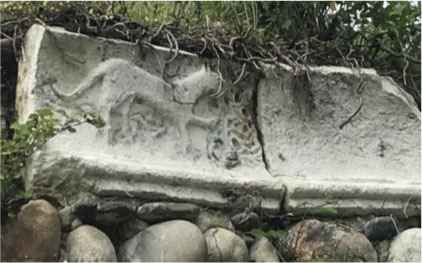
Relief on the White Temple. Photo by V.V. Pishchulina.

Relief on temple in the village of Mramba. Photo from open sources.
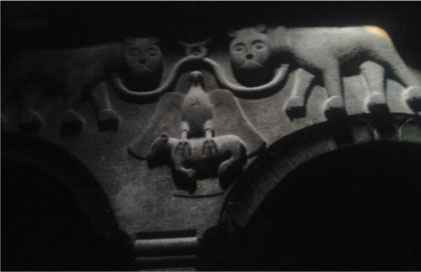
Relief on the Proshians’ mausoleum. Photo from open sources.
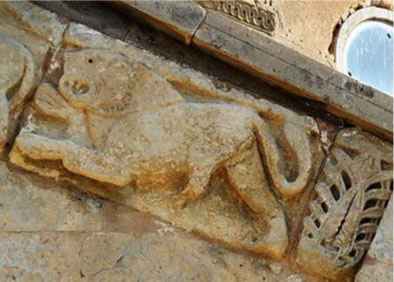
Relief on the temple on Akdamar Island. Photo from open sources.

Relief on the gates of Ani. Photo from open sources.
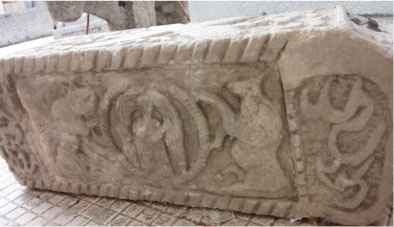
Relief from the museum in Erzincan. Photo from open sources.
The initial outlook of the facades of the White Temple (Cheokhvame), taking into account facing with limestone slabs and reliefs, causes distant associations with sophisticated multi-time decor of the Little Metropolis in Athens (12th century) and the sculpture of the southern antechurch of Sophia of Trebizond (13th century). While the reliefs in situ are executed very carefully, the solar sign mentioned above and the sinuous lines on the collapsed slabs of the molding are cut out more generically.
There are sharp differences in style between the facade reliefs and the motifs which cover the half-destroyed slab which, probably, was a part of the choir screen. The images of crosses framed with a cable stitch are made in a rough manner, with haste, with violations of symmetry. It seems that the cutter gives viewers a hint to a well-known symbol (Fig. 9, Fig. 10) letting them finish it in their imagination (Fig. 11). The figure of the adorant is quite primitive and schematic (Fig. 12). The head and the body are shown full face, legs are turned in profile to the right, and the wrists are grotesquely big. The appearance of iconography with a praying person with raised hands refers back to the Neolithic, examples which are closer in time can be found on the Caucasus in bronze plastic art – the statues of adorants (Fig. 13), dated back not earlier than the 2nd century [15] and the relief of the brass medallion (Fig. 14) from Sukhumi [6]. The Taglan relief with an adorant is made in a style which L.G. Khrushkova aptly names “rural”. A quite close stylistic analogue – the figures on the Alan tomb (Fig. 15) in the Kyafar ancient settlement (11th century).
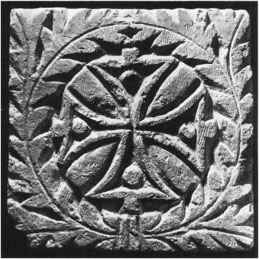
Relief of the 6th century. In: Pushkin State Museum of Fine Arts, Moscow.
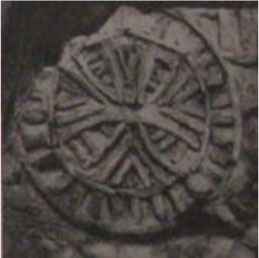
Fragment from the Great Palace of Constantinople (12th century).

Slab near the White Temple. Photo by V.V. Pishchulina.
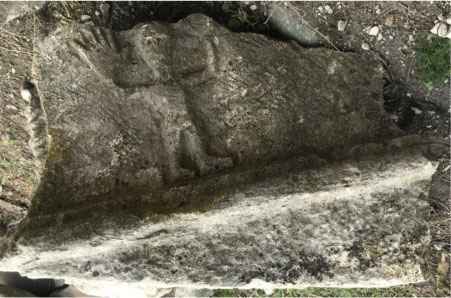
Slab near the White Temple. Photo by V.V. Pishchulina.
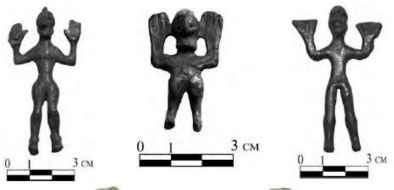
Statues of adorants.
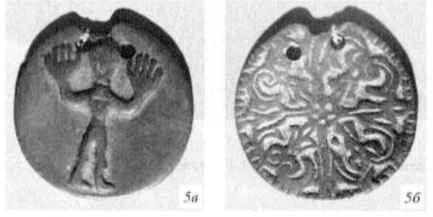
Brass medallion.
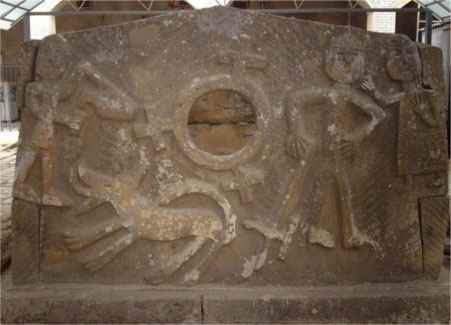
Fragment of the Alan tomb in the Kyafar ancient settlement. Photo from open sources.
4. CONCLUSION
Obvious differences in the stylistics of zoomorphic and anthropomorphic images of the temple cannot directly indicate a chronological gap in their manufacture. Ancient and medieval art knows many examples when images of animals were treated much more realistically than human ones. However, it is also premature to exclude the later manufacture of the slab with an adorant.
Based on the above analogs, we consider it possible to date the reliefs of the White Temple of the village of Taglan to the 11th–13th century. Of course, visual stylistic analysis in relation to the medieval sculpture of Abkhazia, especially considering the stability of iconographic and compositional types of images, in no way can claim absolute reliability. It is necessary to supplement it with natural scientific research, in particular, the X-ray phase method. However, it is safe to say that if the Taglan reliefs chronologically go beyond the political existence of the Abkhazian Kingdom, they undoubtedly have high historical and artistic significance, belong to the cultural field of medieval Abkhazia, and deserve further study.
ACKNOWLEDGMENTS
This research is supported by the FNR Ministry of Russia and RAABS, No. 121111800203-0.
REFERENCES
Cite This Article

TY - CONF AU - Victoria V. Pishchulina AU - Evgenia. M. Kishkinova PY - 2023 DA - 2023/01/10 TI - On the Question of Dating the White Temple in the Village of Taglan, Abkhazia BT - Proceedings of the 4th International Conference on Architecture: Heritage, Traditions and Innovations (AHTI 2022) PB - Athena Publishing SP - 19 EP - 24 SN - 2949-8937 UR - https://doi.org/10.55060/s.atssh.221230.003 DO - https://doi.org/10.55060/s.atssh.221230.003 ID - Pishchulina2023 ER -









